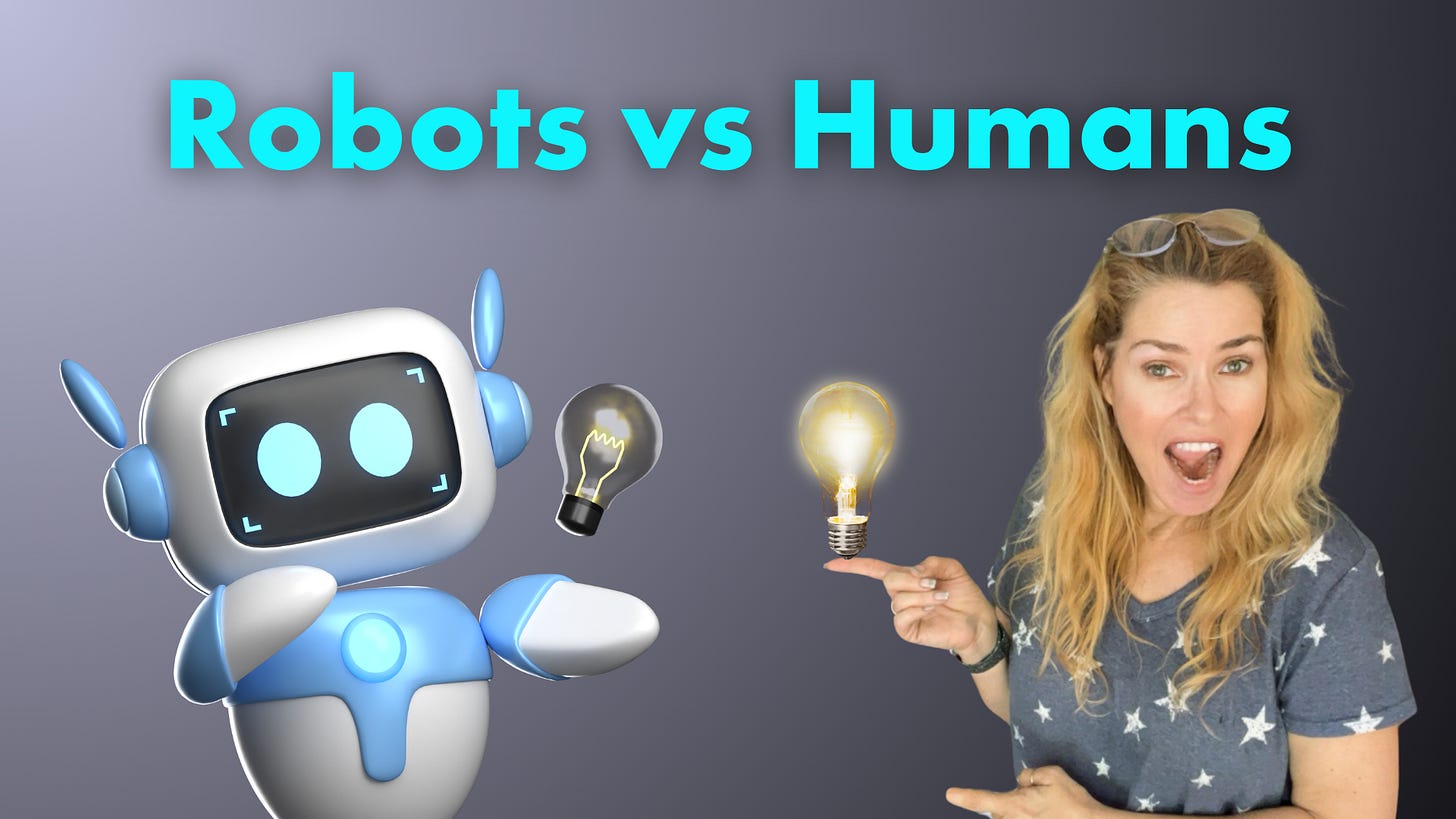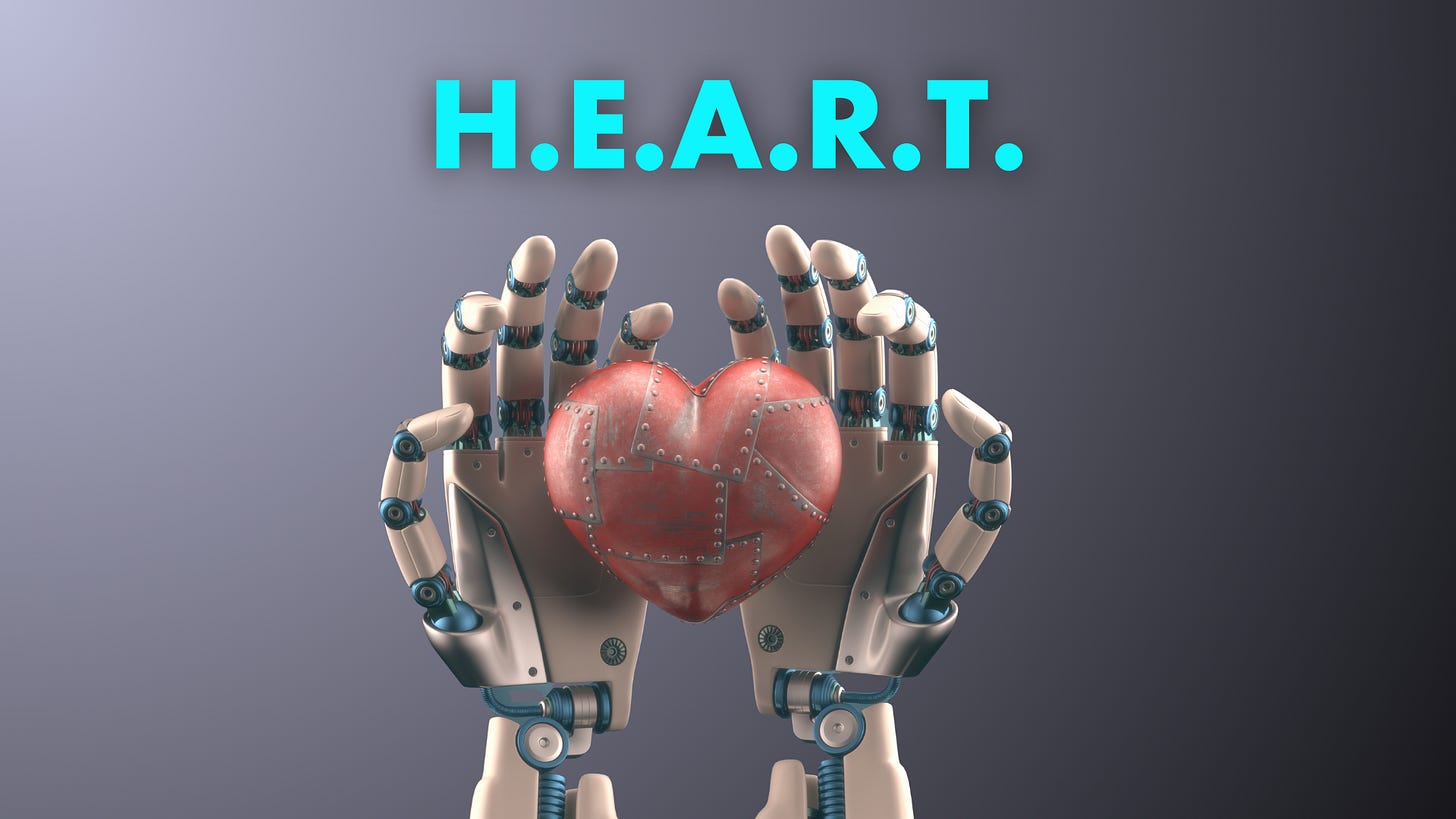✅ A Realist's Guide to AI and Humans
❤️ Introducing the H.E.A.R.T. framework
Summary: Today’s post focuses on a simple framework to help you think through when to use AI and automation and whether to retrain or replace your human workforce. I also look at future unemployment predictions and discuss whether consumers prefer human-made or machine-generated products or services.
Should AI Replace Your Employees? A Realist's Guide.
Every business is asking the same question these days: Can we replace this with AI?
The better question is: Should you?
A few months ago I created Humans vs AI: The Ultimate Corporate Guide, which outlined 9 steps to guide any business through whether you should retrain or replace your human workforce.
👉 Get it now: 🧰 Humans vs AI: The Ultimate Corporate Guide
But is a guide really necessary? Is the threat really that real? I asked ChatGPT to compile some numbers for me, figuring out how many people have lost their jobs recently to AI and automation. (As a reminder, I lost my biggest agency client to AI.)
Here’s where we currently stand, with sources noted.
🏛️ Federal Workforce: AI-Driven Reductions
Current Layoffs: Approximately 220,000 probationary federal employees have been laid off, following directives to reduce staff with less than a year of service. Fed News Network+1Forbes+1
Specific Agency Impact: The Internal Revenue Service (IRS) has announced the layoff of about 6,700 employees, representing roughly 8% of its workforce. The Guardian
Projected Reductions: Estimates suggest that up to 1.2 million positions across the federal workforce, including contractors and grant-supported roles, could be eliminated as AI systems are implemented to streamline operations. Federal Reserve Bank of Atlanta
🏢 Private Sector: AI and Automation Effects
Manufacturing Sector: Since 2000, approximately 1.7 million manufacturing jobs have been lost to automation. Projections indicate that up to 20 million manufacturing jobs could be displaced by robots by 2030. TeamStage
Global Outlook: Goldman Sachs predicts that AI could potentially automate the equivalent of 300 million full-time jobs globally, particularly affecting administrative and repetitive task roles. Wikipedia
Company-Level Changes: Several major corporations, including Klarna, Morgan Stanley, JPMorgan Chase, and Meta, have begun reducing their human workforce in favor of AI systems, signaling a significant shift in the job market. The Guardian
🔮 Future Projections and Considerations
Job Displacement vs. Creation: While AI is expected to displace certain jobs, it is also anticipated to create new roles. The World Economic Forum forecasts that by 2030, 92 million jobs will be displaced by AI/automation globally, while 170 million new jobs will be created, resulting in a net gain of 78 million jobs. LinkedIn
Risk Assessment: Approximately 25% of jobs in the U.S. are at high risk of automation, particularly those involving repetitive and skill-wise undemanding work. TeamStage
‼️ Big and Small Business will be Affected
Maybe you are thinking AI and automation tools are just for the big guys, the mega corporations who can afford to implement such things. Guess again! It is even more vital for mom and pop shops and small businesses to utilize the latest AI tools to be efficient and stay competitive.
Every dollar counts, but the rippled effect on those replaced it very real. So, the questions remain the same: Can we replace this with AI? Should we?
I know some of you business owners (or workers) are resistant, thinking the public prefers human-created content or products, that it is superior due to the human touch… well, only sometimes. If AI created something that is *almost* as good, then most likely it is good enough.
The reason I say “good enough” is because research has already shown that the consumer is often satisfied or even prefers AI-generated content, especially when the origin is unknown. 👀
Here’s ChatGPT’s research on AI vs human work, with sources:
📄 Written Content: Blogs and Articles
Blind Preference for AI Content: A 2024 MIT study found that when participants were unaware of the content's origin, they rated AI-generated marketing copy higher than human-written versions. However, when informed about the source, participants exhibited a bias favoring human-created content, a phenomenon termed "human favoritism" .MIT Sloan
Consumer Engagement with AI Articles: In a survey involving 2,000 UK and US participants, 56% preferred AI-generated articles over those written by humans when the authorship was undisclosed. Conversely, 52% reported reduced engagement when they suspected content was AI-generated, highlighting the influence of perceived authorship on reader engagement .Bynder
Performance Metrics: Research by Neil Patel's agency indicated that while AI-generated content is quicker to produce, human-written articles achieved higher traffic and engagement rates. Specifically, human-created content attracted 5.44 times more traffic than AI-generated content over a five-month period .Neil Patel
🎙️ Voiceovers and Audio Content
Trust in Human Voices: According to Audacy's Innovation Tracker (June 2024), 55% of consumers trust human voices, compared to 23% for AI-generated voices. This preference extends to advertising, where human-crafted audio ads are favored over those produced by AI .Audacy Inc.
AI in Instructional Content: AI-generated voices are increasingly utilized in instructional videos due to their cost-effectiveness and scalability. However, for content requiring emotional nuance or a personal touch, human narrators remain the preferred choice .Create support videos with AI | WowTo
🎯 Key Takeaways on AI Generated Content
Perception Matters: Consumers' satisfaction with AI-generated content often hinges on their awareness of its origin. When unaware, they may rate AI content favorably; when informed, a bias towards human-created content can emerge.MIT Initiative on the Digital Economy+1Upgrow+1
Content Type Influences Preference: AI excels in producing utilitarian content—such as instructional materials—where efficiency is paramount. In contrast, content that relies on emotional connection or storytelling tends to benefit from human involvement.
Hybrid Approaches Are Effective: Combining AI's efficiency with human creativity can yield high-quality content that resonates with audiences, leveraging the strengths of both.
❤️ The H.E.A.R.T. Framework for AI Decisions
On to the point of today’s post: a straightforward, no-spin guide for making that call — balancing money, performance, human value, and a little thing called ethics.
Here’s a step-by-step, realistic framework for making that decision — one that balances financial gains and human value.
H – Highlight Tasks for Automation
E – Evaluate Financial Impact
A – Assess Human Contribution
R – Review AI vs. Human Performance
T – Think Through the Ethics and the Transition
H — Highlight Tasks for Automation
Remember, not everything *should* be automated.
Ask yourself this:
Is the task repetitive and predictable?
Can AI do it faster, cheaper, and just as well?
Does the job require human creativity, judgment, or empathy?
Does the job require a personal relationship with a client?
Is there the public expectation that a human is behind the product, idea, or service?
➡️ Goal: Create a shortlist of tasks where AI could step in AND where is should NOT be.
E — Evaluate Financial Impact
Are there tools available for the task? If so, how much could you actually save with AI — and what will it cost to set it up?
Metrics to check:
Cost savings (labor reduction, fewer errors, higher speed)
Upfront AI investment (software, hardware, setup, training)
Ongoing costs (maintenance, human oversight)
➡️ Goal: Build a basic financial model for AI use to replace the identified tasks.
A — Assess Human Contribution
Now identify what your human workers bring that AI can’t easily replicate?
Think about the creative ideas, nuanced decision-making, deep relationships, public expectation, etc.
Metrics to check:
Employee engagement tied to the task
Impact on morale and company culture
Customer expectation, experience, and brand loyalty
PR that might result if the humans are replaced
➡️ Goal: Create a "Human Value" report before you decide to automate.
R — Review AI vs. Human Performance
Remember, it’s not enough for AI to be cheaper — it has to be better or *almost* as good.
Compare:
Accuracy rates
Speed and reliability
Quality (including the "human touch" where it matters)
Public perception and reception
➡️ Goal: See if AI genuinely improves performance or if it just saves money at a hidden cost.
T — Think Through Transition and Ethics
If you ultimately arrive at the decision to replace your humans, you must manage it thoughtfully—do you retrain or simply replace?
Key things to consider:
Retraining costs and opportunities
Remaining employee morale and loyalty
Public perception and brand reputation
Corporate responsibility to your community
➡️ Goal: Build a retraining and or transition plan before you pull the trigger.
Bonus Tool: The AI Replacement Formula
Want a gut-check before you decide? Use my equation to distill the framework:
AI Replacement Decision (D) = (F + P) - (H + R + E)
Where:
F = Financial savings from AI
P = Performance improvement
H = Human contribution value
R = Retraining/transition costs
E = Ethical impact
If D > 0, AI replacement could make sense.
If D < 0, stick with humans — or find a hybrid solution.
👉 A Final Note: Keep Your H.E.A.R.T.
It’s human nature to want your business to thrive. In today’s business world it is vital to automate and innovate to stay competitive, but I urger you not to forget empathy.
I believe the best future-proof companies will be the ones that use AI wisely, respect their people, and plan for the unexpected.
Because someday — when the power grid fails or a meteor strikes (ha!) — it won't be your chatbot saving the day. It'll be a human.
Choose wisely. Stay human.
Disclosure: I used AI to help me think through this guide as noted above — but the actual writing is me, so excuse the typos. Funny! Today’s post is proof that partnership beats replacement — for now.



